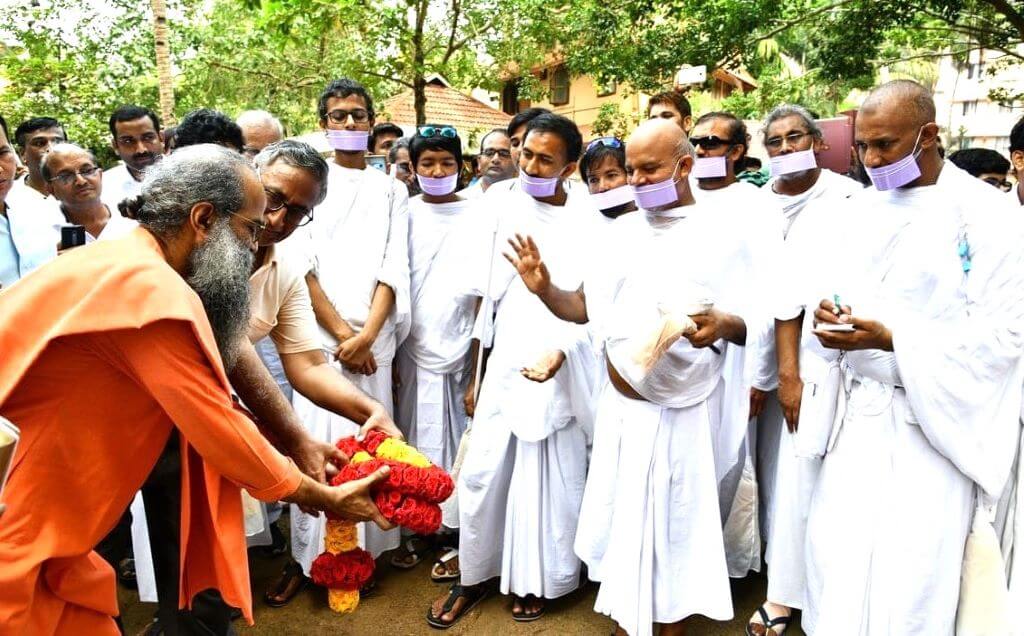The Terapanth Jain sect stands as a symbol of discipline, purity, and devotion in Jainism. Founded by Acharya Shri Bhikshu in the 18th century, the sect has been guided by a continuous line of eleven enlightened Acharyas. Each Acharya played a unique role in spreading the principles of non-violence, truth, and self-discipline across India and beyond.
Let’s explore the inspiring lives of these eleven revered saints who shaped the spiritual journey of the Terapanth.
Lineage of Terapanth Acharyas
Below is the complete lineage of all 11 Terapanth Acharyas (saints) who have shaped and strengthened the community with their wisdom and compassion.
Acharya Shri Bhikshu (1726–1803) – The Founder of the Terapanth Sect
Acharya Shri Bhikshu, also known as Swami Bhikkanaji Maharaj, was born on 1 July 1726 in Kantaliya, Rajasthan. From his early years, he showed a deep interest in spirituality and meditation. His calm nature and quest for truth led him to embrace monkhood on 3 November 1751 at Bagdi, Rajasthan.
During his spiritual journey, Acharya Bhikshu observed that many practices within Jainism had become ritualistic and lacked true discipline. He believed that the essence of Lord Mahavira’s teachings lay in simplicity, self-control, and purity of conduct. With this belief, he founded the Terapanth sect on 23 March 1760 at Bagdi.
The name “Terapanth” signifies either the thirteen guiding principles or the thirteen followers who supported him at the time. His teachings were based on the philosophy of “one Guru, one Principle, and one Thought.” This ensured a unified spiritual direction and a well-organized monastic system under one Acharya’s leadership.
Acharya Bhikshu strongly opposed idol worship and excessive rituals. He emphasized inner worship, focusing on meditation, self-discipline, and moral living. His teachings inspired followers to seek spiritual growth through simplicity and compassion.
Despite facing many hardships and criticism during his early years, Acharya Bhikshu never wavered from his path. Like gold purified in fire, his struggles shaped him into a symbol of truth and resilience. Over time, his reforms gained acceptance, and the Terapanth sect grew into a strong, disciplined community.
Acharya Bhikshu’s legacy is timeless. He not only founded a new religious order but also ignited a spiritual movement that values discipline, purity, and non-violence. His teachings continue to guide the Terapanth community, reminding everyone that true religion lies in self-purification and righteous conduct.
Acharya Shri Bharimal (1803–1821) – The Second Acharya of Terapanth
After the passing of Acharya Shri Bhikshu, the spiritual leadership of the Terapanth sect was taken over by Acharya Shri Bharimal, the second Acharya of the order. His tenure marked an important phase in strengthening and stabilizing the newly founded Terapanth community.
Acharya Bharimal was deeply devoted to the ideals and discipline established by Acharya Bhikshu. He dedicated his life to preserving the principles of truth, simplicity, and unity. Under his leadership, the sect continued to grow in both spiritual and organizational strength.
He ensured that the followers remained committed to the philosophy of “one Guru, one Discipline, and one Path.” His guidance helped the community stay united and firmly rooted in its core values, even in times of change and challenge.
Acharya Bharimal was known for his calm nature, humility, and wisdom. He inspired monks and followers to live a life of self-restraint and non-violence, upholding the true essence of Jainism. His leadership also emphasized moral purity and deep meditation as paths to spiritual progress.
During his Acharyaship, the Terapanth Sangh gained stability and recognition. His efforts laid a strong foundation that allowed future Acharyas to further expand the teachings and influence of the Terapanth order.
Acharya Shri Bharimal’s life serves as a bridge between the founding vision of Acharya Bhikshu and the continued growth of the Terapanth tradition. His devotion, discipline, and service ensured that the sect remained a shining example of spiritual unity and ethical living.
Here’s a blog-style version with short, easy-to-read paragraphs about Acharya Shri Raichand, matching the tone and length of the earlier saints’ sections:
Acharya Shri Raichand (1790–1851) – The Third Acharya of the Terapanth Sect
Acharya Shri Raichand was born in 1790 in the village of Badi Rawaliya, Rajasthan, to Chantraji and Kushalaji. From a young age, he displayed remarkable intelligence and devotion. At just 11 years old, he was initiated into monkhood along with his mother, beginning a life dedicated to spirituality and self-discipline.
He quickly gained mastery over Jain scriptures and was known for his powerful and melodious voice. His discourses inspired many, and his deep knowledge earned him great respect among his peers and mentors, including Acharya Bhikshu and Acharya Bharimal.
On 16 January 1822, Acharya Raichand was appointed as the third Acharya of the Terapanth sect at Rajnagar, Rajasthan. During his leadership, he worked tirelessly to spread the teachings of Terapanth and became the first Acharya to travel across Gujarat, Saurashtra, and Kutch, expanding the reach of the sect.
Acharya Raichand was fearless and compassionate. A famous story tells of how he once confronted a group of robbers while traveling with monks — his calm yet commanding presence made the robbers bow in respect and leave peacefully.
Under his guidance, the Terapanth order flourished, with 77 monks and 168 nuns joining the community. His final years were spent in Udaipur, where he passed away in 1851. Acharya Raichand’s life reflects courage, devotion, and unwavering faith in the principles of Jainism.
Acharya Shri Jeetmal (1803–1881) – The Fourth Acharya of the Terapanth Sect
Acharya Shri Jeetmal was born on 29 September 1803 in Royat, Rajasthan. From a very young age, he showed exceptional intelligence and devotion to learning. At just 10 years old, he was initiated into monkhood on 22 January 1813 in Jaipur, beginning his journey of spiritual pursuit.
He became the fourth Acharya of the Terapanth sect on 5 February 1852 at Bidasar, Rajasthan. Known for his wisdom and simplicity, Acharya Jeetmal dedicated his life to spreading the teachings of Jainism and guiding his disciples with compassion and discipline.
An excellent scholar and poet, he wrote several devotional songs and commentaries on Jain scriptures. His literary works inspired many followers and added a rich spiritual depth to Terapanth literature.
As a leader, Acharya Jeetmal strengthened the organization of the Terapanth order. He maintained strict monastic discipline and emphasized equality among monks and nuns. During his tenure, he initiated 105 monks and 224 nuns, helping the sect grow in both strength and devotion.
Acharya Jeetmal’s life reflected the perfect blend of knowledge, devotion, and discipline. His contributions continue to inspire the Terapanth community toward a life of truth, learning, and inner purity.
Here’s a short-paragraph version of Acharya Shri Maghraj’s profile, written in the same concise and blog-friendly style as before:
Acharya Shri Maghraj (1840–1892) – The Fifth Acharya of the Terapanth Sect
Acharya Shri Maghraj was born on 12 April 1840 in Bidasar, Rajasthan, to Puranmal Ji and Gulaba Ji. From an early age, he showed a strong inclination toward spirituality and self-discipline. He was initiated into monkhood on 20 November 1851 at Ladnun.
His intelligence, humility, and dedication earned him great respect within the community. On 26 August 1881, he was appointed as the fifth Acharya of the Terapanth sect at Jaipur. As a leader, he maintained strict discipline and guided the monks and nuns with wisdom and fairness.
During his leadership, Acharya Maghraj initiated 36 monks and 83 nuns, expanding the Terapanth order while upholding its principles of simplicity, truth, and non-violence.
Acharya Maghraj’s calm nature, balanced judgment, and devotion made him a respected figure in the Jain community. He passed away in 1892, leaving behind a legacy of purity and strength that continued to inspire the Terapanth tradition.
Acharya Shri Manak Lal (1855–1897) – The Sixth Acharya of the Terapanth Sect
Acharya Shri Manak Lal was born in Jaipur in a humble jeweller’s family. After losing his parents early, he was raised by his grandfather, who nurtured his interest in spirituality and simplicity.
At the young age of 16, he accepted monkhood at Ladnun and soon became known for his deep knowledge of Jain scriptures and sincere devotion. His dedication and leadership qualities earned him great respect among the Terapanth followers.
He became the sixth Acharya of the Terapanth sect in 1889. During his short tenure, he worked hard to expand the reach of Jain teachings and was the first Acharya to visit Haryana, spreading the values of peace and non-violence.
Acharya Manak Lal initiated 15 monks and 25 nuns, strengthening the community with discipline and faith. Despite his brief leadership, he made a lasting impact on the Terapanth order.
He passed away at the young age of 42, but his wisdom, humility, and spiritual strength continue to inspire generations within the Jain community.
Acharya Shri Dalchand (1852–1909) – The Seventh Acharya of Terapanth
Acharya Shri Dalchand was born on 21 June 1852 in Ujjain, Madhya Pradesh. From a young age, he showed great maturity and a deep interest in spirituality. At just 14 years old, he accepted monkhood in Indore under his spiritual teacher.
In 1898, he became the seventh Acharya of the Terapanth sect in Ladnun, Rajasthan. Known for his calm nature and sharp intellect, he led the community with discipline and wisdom.
During his tenure, he traveled extensively on padyatras across Rajasthan and Gujarat, spreading the message of non-violence and righteousness. He also initiated over 125 nuns, strengthening the spiritual order.
Acharya Dalchand passed away in 1909 at Bidasar, leaving behind a legacy of devotion, discipline, and deep spiritual insight that continues to guide the Terapanth community today.
Acharya Shri Kalu Ram (1877–1936) – The Eighth Acharya of Terapanth
Acharya Shri Kalu Ram was born on 15 February 1877 in Chhapar, Rajasthan, to Shri Mulchand Chopra and Smt. Choga. From an early age, he displayed a deep sense of devotion and discipline.
He accepted monkhood in 1887 at Bidasar under the guidance of Acharya Shri Maghraj. His sincerity and spiritual maturity made him a respected figure within the Terapanth order.
In 1909, he became the eighth Acharya of the Terapanth sect at Ladnun. During his tenure, he emphasized moral discipline, scriptural study, and unity among followers.
Acharya Kalu Ram’s leadership strengthened the foundation of the Terapanth Sangh, ensuring stability and growth. He passed away in 1936, leaving behind a legacy of calm leadership and unwavering faith.
Acharya Shri Tulsi (1914–1997) – The Ninth Acharya of Terapanth
Acharya Shri Tulsi was born on 20 October 1914 in Ladnun, Rajasthan. He accepted monkhood at the young age of 11, under the guidance of Acharya Shri Kalu Ram.
In 1936, he became the ninth Acharya of the Terapanth sect at Gangapur. A visionary reformer, he launched the Anuvrat Movement, inspiring people of all faiths to follow small vows of truth, non-violence, and morality.
He also founded Jain Vishva Bharati University in Ladnun, which became a major center for spiritual study and meditation. Throughout his life, he wrote over 100 books and walked thousands of miles spreading peace and harmony.
Acharya Tulsi passed away in 1997, leaving behind a legacy of compassion, discipline, and moral awakening that continues to inspire generations.
Acharya Shri Mahapragya (1920–2010) – The Tenth Acharya of Terapanth
Acharya Shri Mahapragya was born on 14 June 1920 in Tamkor, Rajasthan. At the age of 10, he took monkhood and began his journey of spiritual learning and meditation.
He was known for his deep knowledge, discipline, and compassion. As a scholar, he authored over 100 books on philosophy, science, and spirituality.
Acharya Mahapragya developed the famous Preksha Meditation system, promoting self-awareness, peace, and non-violence. He also played a major role in the Anuvrat Movement initiated by Acharya Tulsi.
He became the tenth Acharya of the Terapanth sect in 1995 and continued to spread messages of harmony and inner awakening until his passing in 2010. His teachings remain a guiding light for all seekers of truth.
Acharya Shri Mahashraman (1962–Present) – The Eleventh Acharya of Terapanth
Acharya Shri Mahashraman was born on 13 May 1962 in Sardarshahar, Rajasthan. He accepted monkhood at the age of 12 under the guidance of Acharya Shri Tulsi and was later mentored by Acharya Shri Mahapragya.
In 2010, after the passing of Acharya Mahapragya, he was appointed as the eleventh Acharya of the Terapanth sect. Known for his humility and compassion, he continues to inspire millions with his teachings.
He launched the historic Ahimsa Yatra, walking thousands of kilometres across India to spread the message of peace, non-violence, and moral living. His life reflects simplicity, service, and spiritual discipline.
Contribution of the Terapanth Saints
The Terapanth Acharyas are not only spiritual leaders but also social reformers and teachers of peace.
Their collective contributions include:
- Promoting Anuvrat Movement for moral regeneration.
- Establishing Preksha Meditation centers worldwide.
- Creating educational institutions like Jain Vishva Bharati University.
- Leading Ahimsa Yatras to promote harmony and compassion.
- Inspiring a new generation to live a disciplined, mindful life.
Major Terapanth Centers in India
- Ladnun (Rajasthan) – Headquarters of Terapanth and home to Jain Vishva Bharati University.
- Jaipur, Delhi, Mumbai, Kolkata, Hyderabad – Active centers for meditation and Anuvrat activities.
- Ahmedabad and Surat (Gujarat) – Growing centers for Preksha meditation and youth programs.
Conclusion
The lineage of the 11 Terapanth Jain Acharyas represents over 250 years of spiritual excellence and disciplined guidance. From Acharya Bhikshu’s founding principles to Acharya Mahashraman’s global peace initiatives, every saint has strengthened Jainism’s message of compassion, purity, and truth. Their timeless teachings continue to guide humanity toward inner peace and ethical living.







